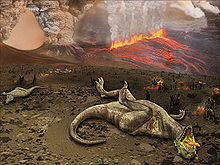We recommend you to develop such answers using your own ideas. However, you may consider the following points:
Natural Disasters
- Cause: Either by of the natural processes of the earth or by exploitation of nature and its resources by human beings.
- Include: earth quakes, volcanic eruption, floods, tornadoes and so on.
- Result: Massive loss of human lives and property.
- Predictability is key to preventing losses caused by these disasters.
- 3
A natural disaster is a major adverse event resulting from natural processes of the Earth; examples include floods, severe weather, volcanic eruptions, earthquakes, and other geologic processes. A natural disaster can cause loss of life or property damage, and typically leaves some economic damage in its wake, the severity of which depends on the affected population's resilience, or ability to recover. An adverse event will not rise to the level of a disaster if it occurs in an area without vulnerable population. In a vulnerable area, however, such as San Francisco, an earthquake can have disastrous consequences and leave lasting damage, requiring years to repair. some diagrams-

- 13
A natural disaster is a major adverse event resulting from natural processes of the Earth; examples include floods, severe weather, volcanic eruptions, earthquakes, and other geologic processes. A natural disaster can cause loss of life or property damage, and typically leaves some economic damage in its wake, the severity of which depends on the affected population's resilience, or ability to recover.
An adverse event will not rise to the level of a disaster if it occurs in an area without vulnerable population.In a vulnerable area, however, such as San Francisco, an earthquake can have disastrous consequences and leave lasting damage, requiring years to repair.
Avalanches
During World War I, an estimated 40,000 to 80,000 soldiers died as a result of avalanches during the mountain campaign in the Alps at the Austrian-Italian front, many of which were caused by artillery fireEarthquakes
. About 60,000 people are thought to have died in this earthquake.
An earthquake is the result of a sudden release of energy in the Earth's crust that creates seismic waves. At the Earth's surface, earthquakes manifest themselves by vibration, shaking and sometimes displacement of the ground. The vibrations may vary in magnitude. Earthquakes are caused mostly by slippage within geological faults, but also by other events such as volcanic activity, landslides, mine blasts, and nuclear tests. The underground point of origin of the earthquake is called the focus. The point directly above the focus on the surface is called the epicenter. Earthquakes by themselves rarely kill people or wildlife. It is usually the secondary events that they trigger, such as building collapse, fires, tsunamis (seismic sea waves) and volcanoes, that are actually the human disaster. Many of these could possibly be avoided by better construction, safety systems, early warning and evacuation planning.
VolVolcanoes can cause widespread destruction and consequent disaster in several ways. The effects include the volcanic eruption itself that may cause harm following the explosion of the volcano or the fall of rock. Second, lava may be produced during the eruption of a volcano. As it leaves the volcano, the lava destroys many buildings and plants it encounters. Third, volcanic ash generally meaning the cooled ash - may form a cloud, and settle thickly in nearby locations. When mixed with water this forms a concrete-like material. In sufficient quantity ash may cause roofs to collapse under its weight but even small quantities will harm humans if inhaled. Since the ash has the consistency of ground glass it causes abrasion damage to moving parts such as engines. The main killer of humans in the immediate surroundings of a volcanic eruption is the pyroclastic flows, which consist of a cloud of hot volcanic ash which builds up in the air above the volcano and rushes down the slopes when the eruption no longer supports the lifting of the gases. It is believed that Pompeii was destroyed by a pyroclastic flow. A lahar is a volcanic mudflow or landslide. The 1953 Tangiwai disaster was caused by a lahar, as was the 1985 Armero tragedy in which the town of Armero was buried and an estimated 23,000 people were killed canic eruptions
Floods
flood is an overflow of an expanse of water that submerges land.[8] The EU Floods directive defines a flood as a temporary covering by water of land not normally covered by water.[9] In the sense of "flowing water", the word may also be applied to the inflow of the tide. Flooding may result from the volume of water within a body of water, such as a river or lake, which overflows or breaks levees, with the result that some of the water escapes its usual boundaries.[10] While the size of a lake or other body of water will vary with seasonal changes in precipitation and snow melt, it is not a significant flood unless the water covers land used by man like a village, city or other inhabited area, roads, expanses of farmland, etc.
Some of the most notable floods include:
Tsunami
Tsunamis can be caused by undersea earthquakes as the one caused by the 2004 Indian Ocean Earthquake, or by landslides such as the one which occurred at Lituya Bay, Alaska.
- The 2004 Indian Ocean Earthquake created the Boxing Day Tsunami.
- On March 11, 2011, a tsunami occurred near Fukushima, Japan and spread through the Pacific

Avlanche

Earthquake

Volcanic eruption
Volcanic eruptions
- -1


